I often write my posts pretty off-the-cuff, and this one will have to be an absolute first impulse, because I have 22% battery power left on my laptop, and no cord here at home. But chances to post come rarely so…
Here are some interesting leads for you to follow up in the book of Micah among the minor prophets, should you be so inclined:
- Micah’s hometown, Moresheth, mentioned in the title (1:1), appears again in the list of towns on the invasion route of Assyria as ‘Moresheth Gath’. Apparently it is represented by a large present-day ruin mound or ‘tell’ overlooking the Shephelah or western foothills of central Israel, or in ancient times, the borderlands of Philistia.
- The call to ‘hear’, using the very common Hebrew term ‘shema‘ in the plural, Micah 1:2, is very like similar calls to attention, or as it were, courtroom summons, at key locations in other prophets, e.g. Micah 6:1, to the mountains; Hosea 4:1, to the Israelites, at the beginning of the body of Hosea, and Isaiah 1:2, to the heavens and the earth as witnesses of Israel’s wrongs.
- To go another verse, the frightening appearance of the LORD in 1:3 is very like the theophanic description in Habakkuk 3, not to mention Psalm 97. When the LORD goes out, the mountains shake and melt like wax, says Micah 1:4, and so does Ps. 97:5 and Nahum 1:5-6. Scholars these days talk about ‘cultural memory’ as a conduit for ancient traditions, and I can’t help but wonder about distant memories of some great volcanic eruption lying behind these descriptions of God’s fearful presence, notwithstanding scholarly pointing to similar mythological traditions in the Ugaritic literature.
- Micah 4:1-3 is famously nearly identical to Isa. 2:1-4, and scholars debate endlessly whose the passage was first, if either prophet’s. It actually finds a very natural ‘bed’ in Micah, because the judgment of the temple ‘mount’ (Heb. har) in 3:12 is immediately reversed in the supreme blessing of the same mount in 4:1.
- Speaking of the devastation of Jerusalem’s ‘mountain’ in 3:12, which would have to be Micah’s most pioneering prophecy, as he was the first to forecast devastation for Jerusalem, along with exile to Babylon (4:10, acknowledging what most scholars would conclude here, but I still suspect it’s Micah’s own), there is a shared word here too. Jerusalem is so destroyed in Micah’s prediction here that it returns to scrub (ya’ar). Yet in 7:14, ya’ar becomes a positive image, as the LORD shepherds his people in the mountain scrublands such as Bashan and Gilead.
- Micah has a Jeremiah-style complaint in ch. 7 beginning in v. 1, which also uses the Hebrew term for ‘summer fruits’ that appears in Amos 8:1.
- Micah 7:17 speaks of foreign leaders coming bowing and scraping to Israel, licking the dust like serpents. As well as a suggestive help for understanding the curse on the snake in Genesis 3, it is very close to Isaiah 65:25, saying “Dust will be the serpent’s food.”
More generally, and my battery’s about to go, I find the relief from the burden of finding a great enough sacrifice to really remedy sin in Micah 6:8 a very prescient passage from a gospel point of view, though no real means of atonement is flagged there. But in 7:18 we do have a God who forgives, rather than staying angry forever, leading to an uplifting and hopeful conclusion that is taken up at the end of Mary’s long in Luke 1:55 or so, as Luke makes the connection between the hopeful texts of the OT prophets and the advent of Christ. God would prove true not just to Jacob but to all the “sons of Adam and daughters of Eve.”









